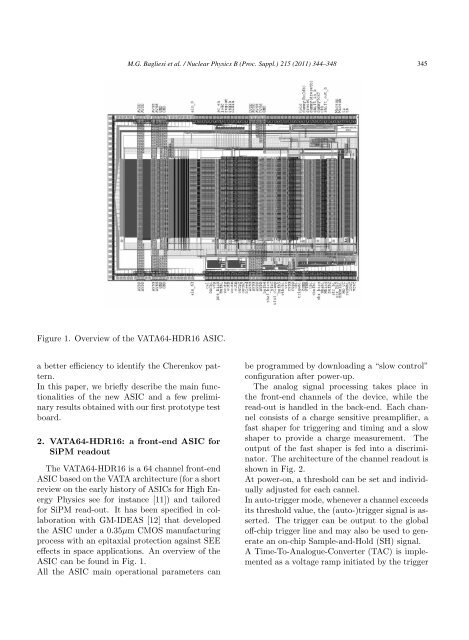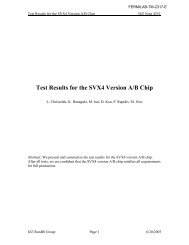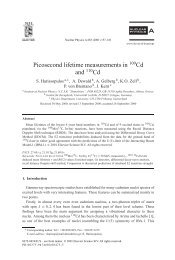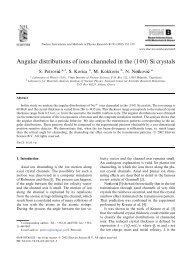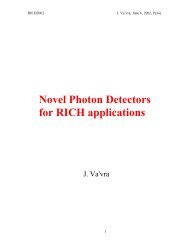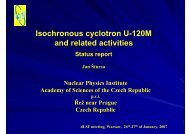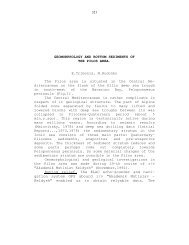A custom front-end ASIC for the readout and timing of 64 SiPM ...
A custom front-end ASIC for the readout and timing of 64 SiPM ...
A custom front-end ASIC for the readout and timing of 64 SiPM ...
You also want an ePaper? Increase the reach of your titles
YUMPU automatically turns print PDFs into web optimized ePapers that Google loves.
M.G. Bagliesi et al. / Nuclear Physics B (Proc. Suppl.) 215 (2011) 344–348 345<br />
Figure 1. Overview <strong>of</strong> <strong>the</strong> VATA<strong>64</strong>-HDR16 <strong>ASIC</strong>.<br />
a better efficiency to identify <strong>the</strong> Cherenkov pattern.<br />
In this paper, we briefly describe <strong>the</strong> main functionalities<br />
<strong>of</strong> <strong>the</strong> new <strong>ASIC</strong> <strong>and</strong> a few preliminary<br />
results obtained with our first prototype test<br />
board.<br />
2. VATA<strong>64</strong>-HDR16: a <strong>front</strong>-<strong>end</strong> <strong>ASIC</strong> <strong>for</strong><br />
<strong>SiPM</strong> <strong>readout</strong><br />
The VATA<strong>64</strong>-HDR16 is a <strong>64</strong> channel <strong>front</strong>-<strong>end</strong><br />
<strong>ASIC</strong> based on <strong>the</strong> VATA architecture (<strong>for</strong> a short<br />
review on <strong>the</strong> early history <strong>of</strong> <strong>ASIC</strong>s <strong>for</strong> High Energy<br />
Physics see <strong>for</strong> instance [11]) <strong>and</strong> tailored<br />
<strong>for</strong> <strong>SiPM</strong> read-out. It has been specified in collaboration<br />
with GM-IDEAS [12] that developed<br />
<strong>the</strong> <strong>ASIC</strong> under a 0.35μm CMOS manufacturing<br />
process with an epitaxial protection against SEE<br />
effects in space applications. An overview <strong>of</strong> <strong>the</strong><br />
<strong>ASIC</strong> can be found in Fig. 1.<br />
All <strong>the</strong> <strong>ASIC</strong> main operational parameters can<br />
be programmed by downloading a “slow control”<br />
configuration after power-up.<br />
The analog signal processing takes place in<br />
<strong>the</strong> <strong>front</strong>-<strong>end</strong> channels <strong>of</strong> <strong>the</strong> device, while <strong>the</strong><br />
read-out is h<strong>and</strong>led in <strong>the</strong> back-<strong>end</strong>. Each channel<br />
consists <strong>of</strong> a charge sensitive preamplifier, a<br />
fast shaper <strong>for</strong> triggering <strong>and</strong> <strong>timing</strong> <strong>and</strong> a slow<br />
shaper to provide a charge measurement. The<br />
output <strong>of</strong> <strong>the</strong> fast shaper is fed into a discriminator.<br />
The architecture <strong>of</strong> <strong>the</strong> channel <strong>readout</strong> is<br />
shown in Fig. 2.<br />
At power-on, a threshold can be set <strong>and</strong> individually<br />
adjusted <strong>for</strong> each cannel.<br />
In auto-trigger mode, whenever a channel exceeds<br />
its threshold value, <strong>the</strong> (auto-)trigger signal is asserted.<br />
The trigger can be output to <strong>the</strong> global<br />
<strong>of</strong>f-chip trigger line <strong>and</strong> may also be used to generate<br />
an on-chip Sample-<strong>and</strong>-Hold (SH) signal.<br />
A Time-To-Analogue-Converter (TAC) is implemented<br />
as a voltage ramp initiated by <strong>the</strong> trigger


